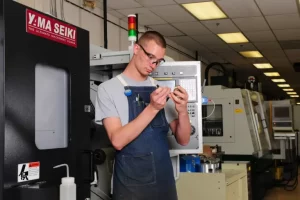HARBEC has made long-standing commitments to our employees and the environment: two passions that go hand-in-hand. Accordingly, we have eliminated many of the negative impacts in a traditional injection molding environment.
HARBEC’s goal to become Carbon Neutral was bold, proactive, and deliberate. HARBEC believes that Carbon Neutrality can be achieved by any business. Although it has taken years of effort, HARBEC’s accomplishment has yielded additional opportunities to continuously improve its energy and carbon performance. Because Carbon Neutrality was such a significant goal to pursue, HARBEC chose to adopt the energy management standard ISO 50001, and the U.S. Department of Energy’s Superior Energy Performance (SEP) process to ensure that a procedure and verifiable method for measuring, monitoring, and calculating energy use, efficiency, and savings is done consistently over time. HARBEC has also adopted a third party carbon footprint validation process which is conducted through annual audits. As a result of ISO 50001/SEP HARBEC has been able to estimate its energy baseline, account for its energy utilization, and dramatically improve its energy performance due to significant energy efficiency and resource utilization improvements.
Adopting proactive energy measurement and management systems including ISO 50001/SEP Platinum provided the sustainable manufacturing path HARBEC was searching for, and the opportunity to reduce the amount of energy per widget forever. Our goal is to eventually meter and report every electrical event in the company and input it to our ERP system. A case study by the Clean Energy Ministerial summarizes HARBEC’s experience to improve energy performance while earning Platinum certification in SEP. HARBEC’s carbon neutrality achievement was accomplished through a deliberate energy and carbon accounting process which included:
- measuring and quantifying an accurate baseline of HARBEC’s annual energy use (and associated carbon emissions)
- using an Eco-Economic decision analysis to implement high-value energy efficiency, on-site renewable, and combined heat and power (CHP) energy technologies
- monitoring energy use with energy management software and systems
- establishing short, mid, and long-term energy goals
- measuring and verifying energy reductions
- purchasing emissions offsets if needed, to account for any differential between what HARBEC was able to achieve in carbon reductions and the balance to achieve carbon neutrality
HARBEC’s energy and carbon accounting process has been made possible by its relationship with DEKRA, a global and independent certification organization. In 2013 DEKRA certified HARBEC to the ISO 50001/SEP “Platinum” certification. DEKRA’s collaboration with HARBEC has been instrumental toward understanding the energy and carbon baseline of HARBEC’s 50,000 square foot facility in Ontario, NY, and further, to help achieve carbon neutrality through energy management, monitoring and assessment; and continuous improvement on energy and carbon goals. HARBEC’s carbon neutrality is comprised of several integrated objectives:
- Measuring and monitoring energy use throughout its facility
- Achieving optimization in the use of energy resources
- Establishing energy reduction targets and proactively pursuing them through eco-economic energy efficiency and management measures and solutions throughout HARBEC’s manufacturing processes and facility
- Deploying, integrating, and optimizing renewable (wind) thermal and electric (combined heat and power) systems
- Purchasing a nominal amount of renewable energy credits from the open market to account for any differentials
- Continuous improvement
After more than 15-years of proactive “eco-economic” operational efficiency improvements at its manufacturing facility, HARBEC continues to add value to its business by advancing opportunities in sustainable manufacturing.
HARBEC’s manufacturing facility intakes approximately 3.64 million gallons of water annually of which 33% (1.2 million gallons) comes from rainwater and 67% (2.44 million gallons) is metered municipal water used for industrial processes and in-facility water requirements.
To achieve Water Neutrality in the industrial sector, HARBEC has had to first establish a baseline of its water demand and use. In addition, 2015 HARBEC became a “Water Performance Pilot Partner” through the USDOE Better Plants Program. (pdf)
Combined with its Water Neutral goal, HARBEC commits to track water use and share data with USDOE as it puts water savings and management measures into place and documents its water savings performance.
To Accomplish its Water Neutrality Goal, HARBEC Has and Continues to Pursue a Number of Specific Initiatives Including:
- Partnering with the U.S. Department of Energy (USDOE) Better Buildings, Better Plants Challenge to conduct a Water Savings Pilot at HARBEC’s 50,000 sq.ft. manufacturing facility
- Monitoring and measuring its facility water use
- Assessing water demand and establishing a clear baseline of how, where, and for what purposes, water is used throughout its facility
- Developing targeted water conservation, efficiency, and management strategies
Water Efficiency, Management, and Conservation Strategies Deployed to Date Include:
- Creating an 800,000-gallon rainwater collection and water retention pond
- Eliminating the use of cooling towers as a manufacturing process requirement
- Metering water use at strategic places within the manufacturing facility and processes
- Adopting a closed-loop Combined Heat and Power (CHP) system which recirculates hot/cold water throughout the facility for thermal energy transfer
 Optimal air quality
Optimal air quality